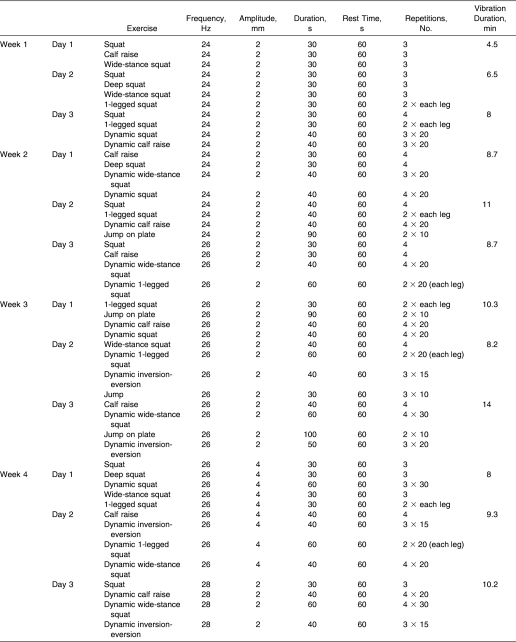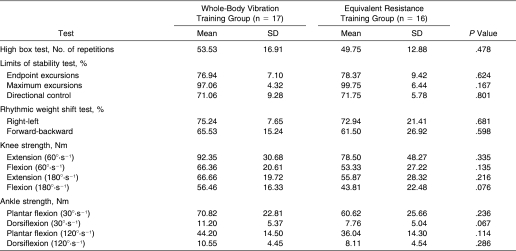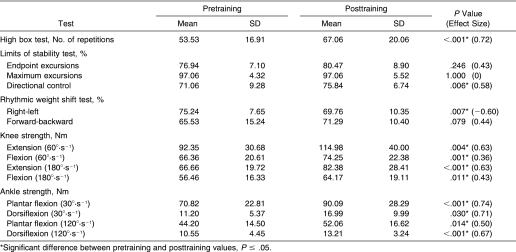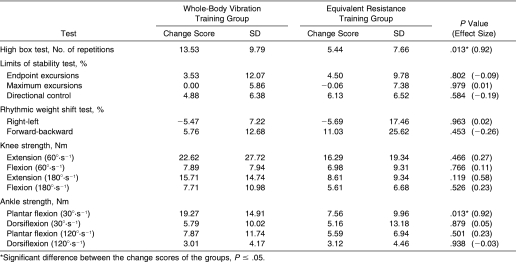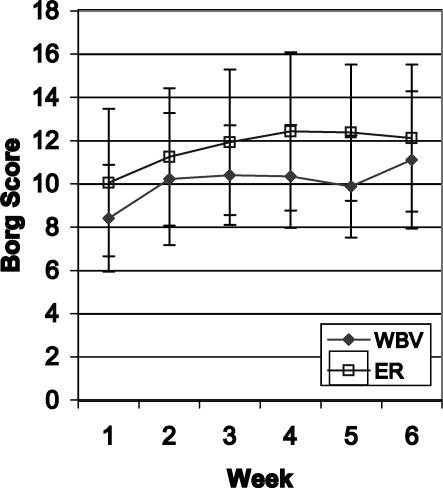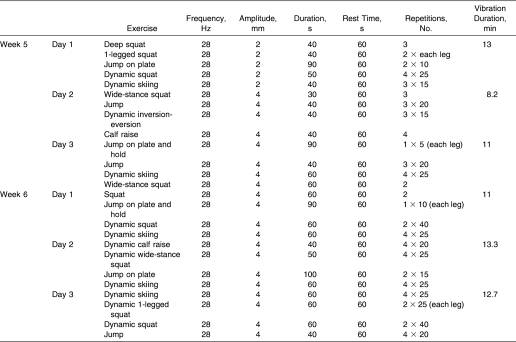Abstract
Context: Several groups have undertaken studies to evaluate the physiologic effects of whole-body vibration (WBV). However, the value of WBV in a training program remains unknown.
Objective: To investigate whether a WBV program results in a better strength and postural control performance than an equivalent exercise program performed without vibration.
Design: Randomized, controlled trial.
Setting: Laboratory.
Patients or Other Participants: Thirty-three Belgian competitive skiers (ages = 9–15 years).
Intervention(s): Subjects were assigned to either the WBV group or the equivalent resistance (ER) group for 6 weeks of training at 3 times per week.
Main Outcome Measure(s): Isokinetic plantar and dorsiflexion peak torque, isokinetic knee flexion and extension peak torque, explosive strength (high box test), and postural control were assessed before and after the training period.
Results: Both training programs significantly improved isokinetic ankle and knee muscle strength and explosive strength. Moreover, the increases in explosive strength and in plantar-flexor strength at low speed were significantly higher in the WBV group than in the ER group after 6 weeks. However, neither WBV training nor ER training seemed to have an effect on postural control.
Conclusions: A strength training program that includes WBV appears to have additive effects in young skiers compared with an equivalent program that does not include WBV. Therefore, our findings support the hypothesis that WBV training may be a beneficial supplementary training technique in strength programs for young athletes.
Keywords: balance, explosive strength, performance enhancement, skiing
Whole-body vibration (WBV) training is a training method that exposes the entire body to mechanical vibrations as the individual stands on a vibrating platform. Mechanical stimulations, characterized by direction, amplitude, velocity, and frequency, are transmitted through the entire body. Recent observations 1–3 have shown the possibility of using these vibration platforms as a training tool in athletic settings. These improvements have been attributed to reflex muscle contractions as a result of a tonic vibration reflex. This reflex contraction is caused by an excitation of muscle spindles, leading to enhanced activity of the Ia loop. 4–6
Most of the authors who have evaluated the effects of WBV have shown that muscular properties can be improved with its use. 3 For example, Bosco et al 7 showed that a single vibration bout of 5 repetitions lasting 1 minute each resulted in a significant temporary increase in muscle strength of the lower extremities and arm flexors. In another study, Bosco et al 8 trained volleyball players with 10 repetitions at 60 seconds each. Bosco et al 9 also studied the effects of a 10-day vibration program on the muscular performance of physically active persons and noted enhanced explosive power. Other authors investigated the effects of WBV programs using randomized, controlled study designs. 10–13 For example, Torvinen et al 11 randomized 56 young adults to either a vibration group or a control (no training) group. Jumping power was enhanced 8.5% after a 4-month WBV intervention. More recently, investigators 1, 2, 12, 13 demonstrated that WBV training has the potential to induce strength gains to the same extent as a traditional resistance training program. Consequently, on the basis of these studies, we can conclude that WBV is a training method equivalent to conventional resistance training.
However, despite the growing popularity of WBV, authors of a recent review 3 claimed that it still lacks randomized scientific research, especially concerning its adaptation to dynamic exercises. To date, only 1 author 14 has undertaken to determine the supplemental value of WBV with an equivalent training program. Ronnestad 14 compared the performance-enhancing effects of squats on a vibration platform with conventional squats executed on the ground. Thus, identical exercises were executed in both groups. The intervention period lasted 5 weeks. Although the results did not reach the level of statistical significance, the trend was toward better results in maximal strength and explosive power for the squats performed on a vibration platform. In order to further investigate this possibility, our purpose was to evaluate the training effects of a WBV program compared with an equivalent exercise program performed without vibration.
METHODS
Experimental Design
We randomly divided 33 competitive skiers into a WBV group (n = 17) and an equivalent resistance (ER) training group (n = 16). Both groups trained for 6 weeks at a frequency of 3 times a week, with at least 1 day of rest between sessions. Each training session lasted 30 minutes, including warm-up, exercises, rest periods, and cool-down. After each session, the subjects were asked to report possible side effects or adverse reactions in their personal training diaries. After every training week, they also completed a Borg scale, a simple method of rating perceived exertion. 15 Before starting the study, as well as after the 6 weeks of training, we evaluated all subjects for postural control and isokinetic and explosive strength.
Subjects
The subjects were 33 competitive skiers (age = 12.36 ± 1.71 years, range = 9–15 years) of the Flemish Ski Federation: 12 girls and 21 boys (WBV = 11 boys and 6 girls; ER = 8 boys and 8 girls). We excluded skiers with a history of any type of injury in the last 2 years or a possible contraindication for WBV (diabetes, epilepsy, metabolic or neuromuscular diseases, osteoporosis, osteoarthrosis, prosthesis, menstrual irregularities, or orthopaedic injuries, according to Roelants et al 2). Persons who were already participating in another strength program were excluded from the study as well. All children and their parents gave written informed consent to participate. The study was approved by the Ethical Committee of Ghent University. The anthropometric and training characteristics of the subjects are presented in Table 1.
Table 1. Subjects' Anthropometric and Training Characteristics.
Whole-Body Vibration Training
Vibration loading was carried out on a WBV platform (Fitvibe; N.V. GymnaUniphy, Bilzen, Belgium) in a standing position. The program consisted of squatting, deep squatting, wide-stance squatting, 1-legged squatting, calf raises, skiing movements, jumps onto the plate, and light jumping (Table 2). After each exercise, the skiers were allowed to rest for 2 minutes before starting the following exercise. Training intensity was increased over the 6 weeks by increasing the amplitude (from 2 to 4 mm) and frequency (from 24 to 28 Hz) of the vibration, the duration of the exercise, and the number of repetitions. Also, the number of repetitions of 1 exercise and the number of different exercises increased systematically over the 6-week training period. During all training sessions, the subjects completed a personal exercise diary and were under the strict supervision of a physiotherapist.
Table 2. Whole-Body Vibration Training Program.
Equivalent Resistance Training
In order to achieve the goal of our study, the ER training was composed of exactly the same exercises as the WBV training. The only difference was that the ER training group did not perform the exercises on a vibration platform but on the floor. Subjects in both groups wore sport shoes during the training sessions. They completed a personal exercise diary and were contacted every week for supervision of their training program. Each week, a physiotherapist conducted a joint training session with both groups to teach the new exercises being added to the programs.
Evaluation
Isokinetic Muscle Strength
Isokinetic performance of the right calf muscles was measured with a Biodex System 3 isokinetic dynamometer (Biodex Medical Systems Inc, Shirley, NY). The dynamometer was calibrated as part of the regular schedule for maintenance of equipment used for the testing device.
Plantar flexors and dorsiflexors of the right ankle were concentrically measured at 30°·s −1 (3 repetitions) and 120°·s −1 (5 repetitions). All subjects assumed the standard position for testing isokinetic ankle movement, according to the guidelines of Dvir. 16 This protocol is reliable. 17 The subject was positioned in the chair with the knee fully extended. The right foot was placed on a footplate and held in place with 2 tight straps for further stabilization. The ankle joint of the subject was aligned with the axis of the dynamometer. The reference angle corresponded to the ankle's neutral position (90°). The movement range covered the entire comfortable active range of motion of the subject's ankle joint. Above the knee, the leg was restricted with hook-and-loop straps to avoid compensatory flexion movements. Before the tests, the subject received instructions about the procedures and was requested to perform a warm-up of 10 submaximal repetitions. This warm-up procedure allowed subjects to become familiar with performing isokinetic exercises on the Biodex dynamometer. The same investigator (N.N.M.), who was familiar with isokinetic testing, performed all tests. During the test, subjects were instructed to give 100% effort and received positive feedback. The values of the peak torque (Nm) of the right plantar flexors and dorsiflexors were used for the data analysis. The peak torque was determined as the single repetition with the highest muscular force output (Nm) of the multiple test trials.
The right knee flexor and extensor muscles were tested concentrically at 60°·s −1 and 180°·s −1, according to the guidelines of Dvir. 16 The subject was strapped into the chair, using the right lateral femoral condyle as an anatomical reference for the axis of rotation on the Biodex. 16 This protocol is reliable. 18 The subject completed 5 repetitions of knee flexion and extension at a speed of 60°·s −1 and 10 repetitions at 180°·s −1. The upper leg, hips, and shoulders were stabilized with safety belts. The subject was instructed to submaximally flex and extend the knee 10 times at each speed to become familiar with the procedure. The principal investigator (N.N.M.) instructed the subject to extend and flex the knee at full force throughout the test. The values of the peak torque (Nm) of the right knee flexors and extensors were used for the data analysis.
Explosive Strength
We chose the high box test to assess more ski-specific explosive strength, agility, and coordination. 19, 20 Significant correlations have been noted between skiing performance time and the high box test. 19, 21 In our study, a box with a height of 30 cm was used. The subject started by standing beside the box. On command, the subject jumped laterally up onto the box and then down off the other side. This was done continuously for 90 seconds. Performance was the number of jumps completed in 90 seconds. 19
Postural Control
We tested postural control with the Balance Master (NeuroCom International, Inc, Clackamas, OR). The vertical ground reaction forces were used to calculate the position of the center of pressure and the equivalent center-of-gravity (COG) sway angles. The reproducibility of the postural control tests on the Balance Master has been reported to be good to excellent. 22 Each subject was allowed to become familiar with the system and performed 1 trial before proceeding to the tests. The tests for postural control in our study were the limits of stability test and the rhythmic weight shift test.
The limits of stability test is a dynamic standing balance test that measures the stable support in a controlled manner. 23 The test was performed in bipedal stance. We asked the subject to shift COG from the center to each of the 8 peripheral targets. These targets were positioned forward, forward right, right, backward right, backward, backward left, left, and forward left. During the assessment, the locations of the subject's COG and the peripheral targets were displayed on a screen. The subject could control the COG by shifting weight. We instructed the subject to move the COG cursor on command as quickly and accurately as possible toward 1 of the targets located on the limits of stability perimeter and then hold a position as close to the target as possible. The subject was allowed up to 8 seconds to complete each trial. The subject was instructed to lean forward to the target as much as possible without bending the hips or lifting the heels or toes off the ground. Three values were used in the data analysis. The endpoint excursion is the distance travelled by the COG on the primary attempt to reach the target, expressed as a percentage of the limits of stability. The maximum excursion is the furthest distance travelled by the COG during the trial, and the directional control is a comparison of the amount of movement in the intended direction to the amount of extraneous movement; both values are also expressed as percentages.
The rhythmic weight shift test quantifies the subject's ability to rhythmically move the COG from left to right and from forward to backward between 2 targets. 23 As in the limits of stability test, the subject's COG is displayed on a screen as a cursor providing visual feedback. We instructed the subject to rhythmically move the COG cursor from side to side or front to back between the 2 targets. With the COG cursor, the subject was asked to follow an on-screen cue at the same speed as it moved between the endpoints. The 2 values measured were the directional control in the left-right excursion and in the front-back excursion. Both values were expressed as percentages, ie, a perfect directional control score equaled 100%.
Statistical Procedures
We performed the statistical analysis with the Statistical Package for the Social Sciences (version 11.0; SPSS Inc, Chicago, IL). The data were analyzed using the Kolmogorov-Smirnov test. Independent t tests were used to compare the baseline characteristics of the groups. Paired-samples t tests were calculated for within-group comparisons. Between-group differences were analyzed by means of independent t tests on the change scores of both groups. The change score of a group was defined as the increase or decrease from pretraining to posttraining by that group. We similarly evaluated the results of the Borg scales for perceived exertion on the basis of paired and independent t tests. The effect size associated with the changes for each measure in both groups was calculated by the following formula: (posttraining mean − pretraining mean)/pooled SD of pretraining and posttraining. The effect size of the difference in change scores between the groups was calculated by the following formula: (WBV change score mean − ER change score mean)/pooled SD of WBV and ER change scores. According to Rhea, 24 a value of less than 0.25 represents a trivial effect size; 0.25 to 0.50, a small effect size; 0.50 to 1.00, a moderate effect size; and more than 1.0, a large effect size. For all analyses, the level of statistical significance was set at P ≤ 0.05.
RESULTS
Pretraining Results
Independent t tests revealed no significant differences between the 2 groups at the beginning of the study ( Table 3).
Table 3. Baseline Characteristics.
Posttraining Results
Equivalent Resistance Training Group
Performance on the high box test increased significantly in the ER group after the training period (Table 4). Moreover, all isokinetic muscle strength values improved significantly except for dorsiflexor strength at low speed. None of the postural control measurements increased significantly except for the directional control during the limits of stability test. Most significant values showed a small effect size.
Table 4. Training Effects Within the Equivalent Resistance Training Group.
Whole-Body Vibration Group
Performance on the high box test increased significantly after 6 weeks of vibration training (Table 5). Also, all ankle and knee isokinetic muscle strength measurements showed significant increases after the training period. Most postural control values did not increase significantly except for directional control during the limits of stability test and the left-right excursion of the rhythmic weight shift test. Most significant values showed a moderate effect size.
Table 5. Training Effects Within the Whole-Body Vibration Group.
Comparisons Between Training Programs
The increased performance on the high box test in the WBV group was significantly greater than the increase in the ER group (Table 6). Moreover, the increase in plantar-flexor strength at low speed was also significantly higher in the WBV group. For all other values, we found no significant differences between the change scores of the groups. All significant values showed a moderate effect size.
Table 6. Comparisons Between Training Programs.
Perception of Exertion of the Exercise Programs
No significant differences were noted between the WBV and ER groups except for the Borg score in the fifth week, when the ER group rated the exercise program as more intense than the WBV group (Figure). Within each group, the Borg score in week 6 was significantly higher than the score in week 1.
Perceived exertion of the training programs. Each value represents the mean Borg score of each training week. No significant differences were noted between the groups except during week 5 ( P = .015). WBV indicates whole-body vibration training group; ER, equivalent resistance training group .
DISCUSSION
Both a WBV program and an ER training program improved isokinetic ankle and knee muscle strength and the explosive strength of the subjects after a 6-week training period. These findings are in accordance with those of several authors, affirming that WBV increases the dynamic strength of the lower extremity muscles. 1, 2, 8, 11 Roelants et al 2 investigated the effects of 24 weeks of WBV on knee extension strength in 89 postmenopausal women in a randomized controlled study. Isokinetic and dynamic strength of the knee extensors increased in both WBV and traditional resistance training groups, with the training effects not significantly different between the groups. Similarly, Delecluse et al 1 concluded that a WBV program can induce a strength gain in the knee extensors of previously untrained females to the same extent as a traditional resistance training program. In these studies, the traditional resistance training programs and vibration programs consisted of different exercises. Therefore, whether WBV training had an additional training value remains uncertain.
In our study, the ER training program consisted of exactly the same exercises as in the WBV group in order to evaluate the supplemental value of vibration training. Interestingly, our results reveal that the gains in explosive strength and in plantar-flexor strength at low speed were significantly higher in the WBV group than in the ER group after 6 weeks of training.
Using the same study design, Ronnestad 14 concluded that the maximal strength of recreationally resistance-trained men increased significantly more after 5 weeks of a vibration program than after an equivalent training program.
Previous authors 1, 2, 14, 25 have tried to find a plausible explanation for these positive effects of vibration training. Some investigators have suggested that the large strength gain is the result of the tonic vibration reflex. They stated that standing on a vibration plate provokes length changes in the muscle that stimulate the muscle spindles. (In these studies, knee flexor and extensor muscles were tested.) These receptors would elicit the tonic vibration reflex. In addition, it has been proposed 1 that the recruitment thresholds of the motor units during WBV are expected to be lower than during voluntary contractions, probably resulting in a more rapid activation and training of high-threshold motor units. Therefore, it has been suggested that WBV training specifically trains fast-twitch fibers, 1, 26 which are responsible for explosive power.
In our study, the WBV group showed a significantly greater gain on the high box test than the ER group after 6 weeks of training. This finding is in agreement with results of previous studies that showed that WBV training has a positive effect on explosive strength. Delecluse et al 1 reported that jumping height increased significantly over 12 weeks in the WBV group and remained unchanged in the 3 other groups (control, placebo, and traditional resistance training). Also, Ronnestad 14 found a significant improvement in vertical jumping height after subjects performed squats on a vibration platform for 5 weeks.
In our study, neither WBV nor ER training for 6 weeks resulted in a convincing effect on postural control. This finding is in agreement with that of Torvinen et al, 11 who showed that 4 months of vibration training produced no effect on the dynamic or static balance of young, healthy subjects. However, stroke patients with unilateral impairment showed an increase in their weight-shifting speed at the balance assessment after 1 session of WBV training. 27 In geriatric patients, WBV training improved postural control. 10 After 4 months of training, chair-rising time improved 18% in fit elderly participants, whereas the control group showed no significant differences. Consequently, we can speculate that WBV training only has a positive significant effect when the postural control of the subjects is disturbed.
In order to rate the perceived exertion of both training programs, each subject completed a Borg scale after each training week. No significant differences were noted between the groups except during week 5, when the WBV group rated the exercises lower (easier). We know that the amplitude of the vibrations was reduced from 4 mm to 2 mm just before week 5, whereas the frequency increased from 26 Hz to 28 Hz. It is possible that the amplitude of the vibrations had an important influence on the perceived exertion of the subjects. In previous studies, attention was paid only to the frequency of the vibrations.
The limitations of our study should be noted. Although the WBV training group showed a significantly greater gain in explosive strength and in plantar-flexor strength at low speed, we should take into account the fact that the WBV group was bigger and older than the ER group at baseline. Therefore, we have analyzed the change scores of both groups and not the absolute end values. In our study, no true control group was included. One could suggest that the young subjects might have had strength improvements regardless of training. Another limitation of our study was that we have not studied the length of the training effects. Therefore, future researchers should include a follow-up of the length of the training effects. Finally, not performing a Bonferroni correction in order to take type I errors into account when analyzing several dependent variables is also an important limitation of our study.
In conclusion, neither WBV training nor ER training seemed to have an effect on the postural control of young healthy skiers. However, both training programs improved isokinetic ankle and knee muscle strength and explosive strength after 6 weeks of training. Moreover, WBV training resulted in a significantly greater gain in explosive strength and plantar-flexor strength at low speed compared with ER training after 6 weeks. Therefore, our findings support the hypothesis that WBV training can be a beneficial addition to traditional strength programs.
Table 2. Continued.
Acknowledgments
We thank all the participants for taking part in this study. We also thank L. Samsom, G. Buts, and T. Coeckelberghs for their help in recruiting the subjects and the firm N.V. Gymna (Belgium) for providing the Fitvibe vibration platforms.
REFERENCES
- Delecluse C, Roelants M, Verschueren S. Strength increase after whole-body vibration compared with resistance training. Med Sci Sports Exerc. 2003;35:1033–1041. doi: 10.1249/01.MSS.0000069752.96438.B0. [DOI] [PubMed] [Google Scholar]
- Roelants M, Delecluse C, Verschueren S. Whole body vibration training increases knee-extension strength and speed of movement in older women. J Am Geriatr Soc. 2004;52:901–908. doi: 10.1111/j.1532-5415.2004.52256.x. [DOI] [PubMed] [Google Scholar]
- Luo J, McNamara B, Moran K. The use of vibration training to enhance muscle strength and power. Sports Med. 2005;35:23–41. doi: 10.2165/00007256-200535010-00003. [DOI] [PubMed] [Google Scholar]
- Burke RE, Rymer WZ. Relative strength of synaptic input from short-latency pathways to motor units of defined type in cat medial gastrocnemius. J Neurophysiol. 1976;39:447–458. doi: 10.1152/jn.1976.39.3.447. [DOI] [PubMed] [Google Scholar]
- Roll JP, Vedel JP, Ribot E. Alteration of proprioceptive messages induced by tendon vibration in man: a microneurographic study. Exp Brain Res. 1989;76:213–222. doi: 10.1007/BF00253639. [DOI] [PubMed] [Google Scholar]
- Cardinale M, Lim J. The acute effects of two different whole body vibration frequencies on vertical jump performance. Med Sport. 2003;56:287–292. [Google Scholar]
- Bosco C, Cardinale M, Tsarpela O. Influence of vibration on mechanical power and electromyogram activity in human arm flexor muscles. Eur J Appl Physiol Occup Physiol. 1999;79:306–311. doi: 10.1007/s004210050512. [DOI] [PubMed] [Google Scholar]
- Bosco C, Colli R, Introini E. Adaptive responses of human skeletal muscle to vibration exposure. Clin Physiol. 1999;19:183–187. doi: 10.1046/j.1365-2281.1999.00155.x. et al. [DOI] [PubMed] [Google Scholar]
- Bosco C, Cardinale M, Tsarpela O. The influence of whole body vibration on the mechanical behaviour of skeletal muscle. Biol Sport. 1998;15:157–164. et al. [Google Scholar]
- Runge M, Rehfeld G, Resnicek E. Balance training and exercise in geriatric patients. J Musculoskelet Neuronal Interact. 2000;1:64–65. [PubMed] [Google Scholar]
- Torvinen S, Kannus P, Sievänen H. Effect of four-month vertical whole body vibration on performance and balance. Med Sci Sports Exerc. 2002;34:1523–1528. doi: 10.1097/00005768-200209000-00020. et al. [DOI] [PubMed] [Google Scholar]
- Rittweger J, Just K, Kautzsch K, Reeg P, Felsenberg D. Treatment of chronic lower back pain with lumbar extension and whole-body vibration exercise: a randomized controlled trial. Spine. 2002;27:1829–1834. doi: 10.1097/00007632-200209010-00003. [DOI] [PubMed] [Google Scholar]
- Verschueren S, Roelants M, Delecluse C, Swinnen S, Vanderschueren D, Boonen S. Effect of 6-month whole body vibration training on hip density, muscle strength, and postural control in postmenopausal women: a randomized controlled pilot study. J Bone Miner Res. 2004;19:352–359. doi: 10.1359/JBMR.0301245. [DOI] [PubMed] [Google Scholar]
- Ronnestad BR. Comparing the performance-enhancing effects of squats on a vibration platform with conventional squats in recreationally resistance-trained men. J Strength Cond Res. 2004;18:839–845. doi: 10.1519/14573.1. [DOI] [PubMed] [Google Scholar]
- Dunbar CC, Robertson RJ, Baun R. The validity of regulating exercise intensity by ratings of perceived exertion. Med Sci Sports Exerc. 1992;24:94–99. et al. [PubMed] [Google Scholar]
- Dvir Z. Isokinetics: Muscle Testing, Interpretation, and Clinical Applications. 2nd ed. London, United Kingdom: Churchill Livingstone; 2004.
- Karnofel H, Wilkinson K, Lentell G. Reliability of isokinetic muscle testing at the ankle. J Orthop Sports Phys Ther. 1989;11:150–154. doi: 10.2519/jospt.1989.11.4.150. [DOI] [PubMed] [Google Scholar]
- Tredinnick TJ, Duncan PW. Reliability of measurements of concentric and eccentric isokinetic loading. Phys Ther. 1998;68:656–659. doi: 10.1093/ptj/68.5.656. [DOI] [PubMed] [Google Scholar]
- Andersen RE, Montgomery DL, Turcotte RA. An on-site test battery to evaluate giant slalom skiing performance. J Sports Med Phys Fitness. 1990;30:276–282. [PubMed] [Google Scholar]
- Kornexl E. Das sportmotorische Eigenscaftsniveau des Alpinen Schirennlaufers [dissertation] Innsbruck, Austria: University of Innsbruck; 1977.
- Shea JB. The Alpine skiing assessment battery: the secret of picking the right people and training for the right things. Ski Coach. 1983;6:26–31. [Google Scholar]
- Van de Vijver I, Wynant K. New Balance Master: Research to the Reliability in a Healthy Population [master's thesis] Ghent, Belgium: Ghent University; 1999.
- Nallegowda M, Singh U, Bhan S, Wadhwa S, Handa G, Dwivedi SN. Balance and gait in total hip replacement: a pilot study. Am J Phys Med Rehabil. 2003;82:669–677. doi: 10.1097/01.PHM.0000083664.30871.C8. [DOI] [PubMed] [Google Scholar]
- Rhea MR. Determining the magnitude of treatment effects in strength training research through the use of the effect size. J Strength Cond Res. 2004;18:918–920. doi: 10.1519/14403.1. [DOI] [PubMed] [Google Scholar]
- Sale DG. Influence of exercise and training on motor unit activation. Exerc Sport Sci Rev. 1987;15:95–151. [PubMed] [Google Scholar]
- Rittweger J, Beller G, Felsenberg D. Acute physiological effects of exhaustive whole-body vibration exercise in man. Clin Physiol. 2002;20:134–142. doi: 10.1046/j.1365-2281.2000.00238.x. [DOI] [PubMed] [Google Scholar]
- van Nes IJW, Geurts ACH, Hendricks HT, Duysens J. Short-term effects of whole-body vibration on postural control in unilateral chronic stroke patients: preliminary evidence. Am J Phys Med Rehabil. 2004;83:867–873. doi: 10.1097/01.phm.0000140801.23135.09. [DOI] [PubMed] [Google Scholar]




